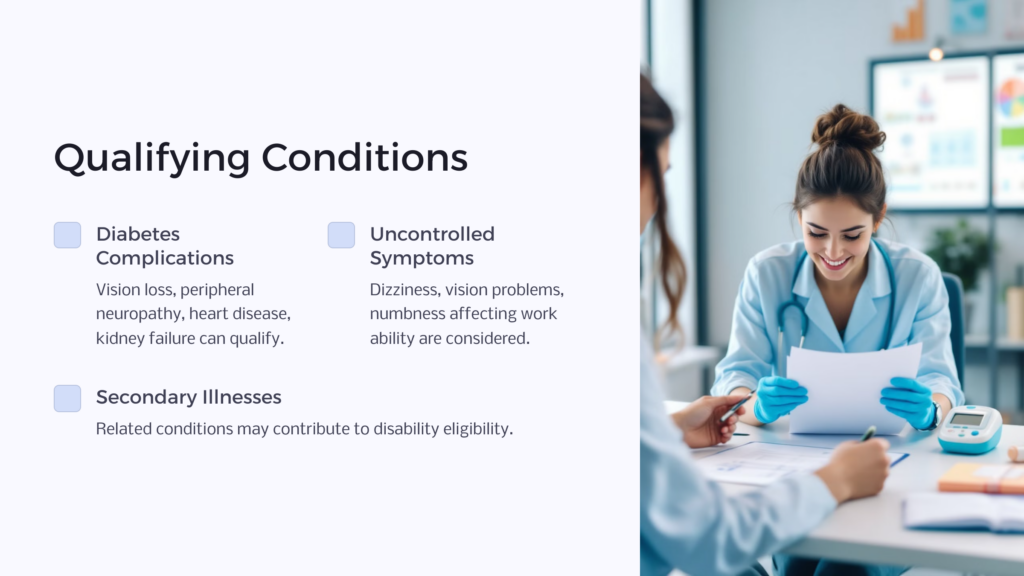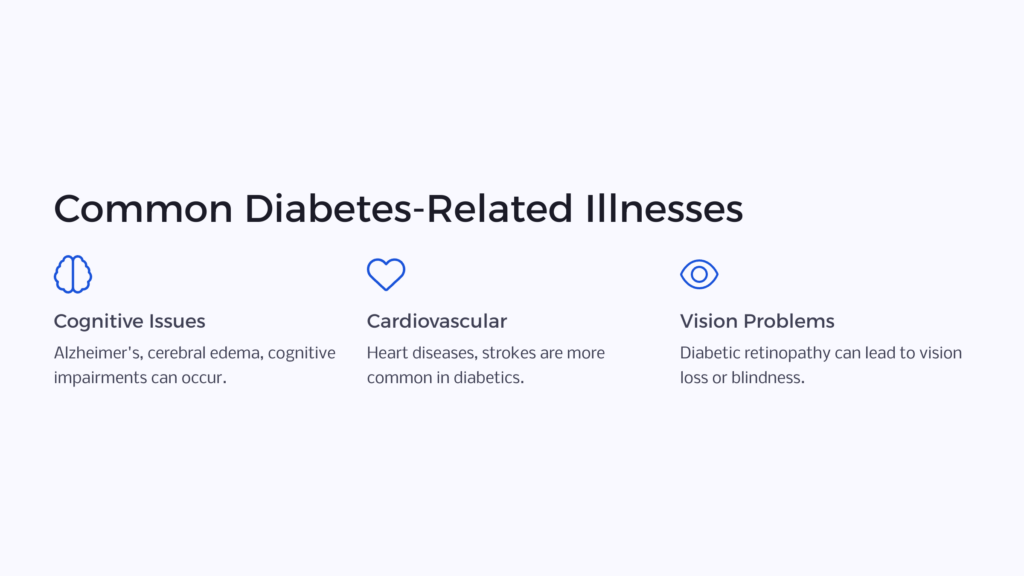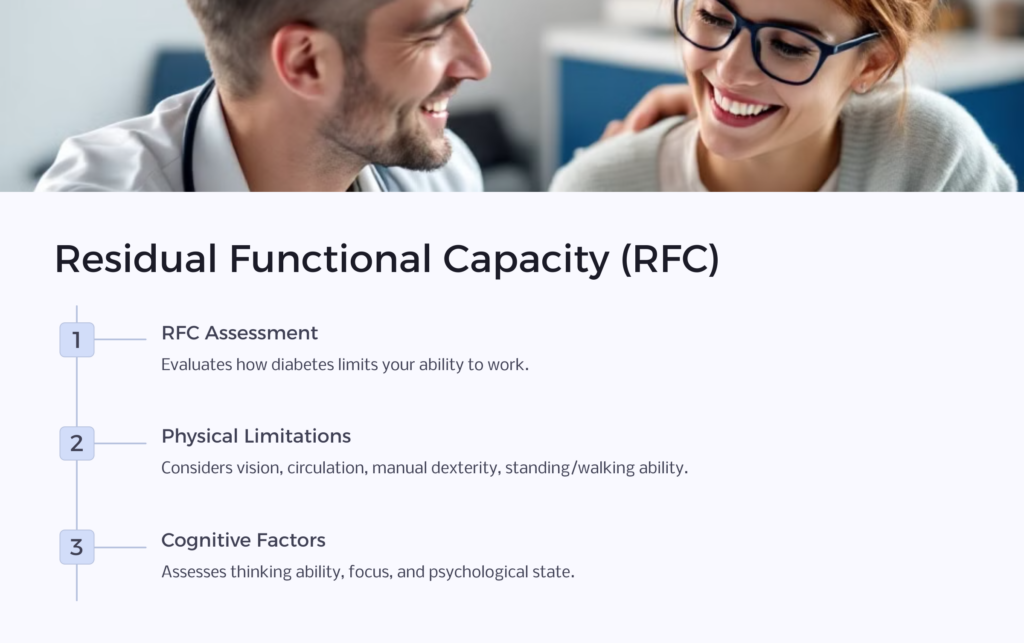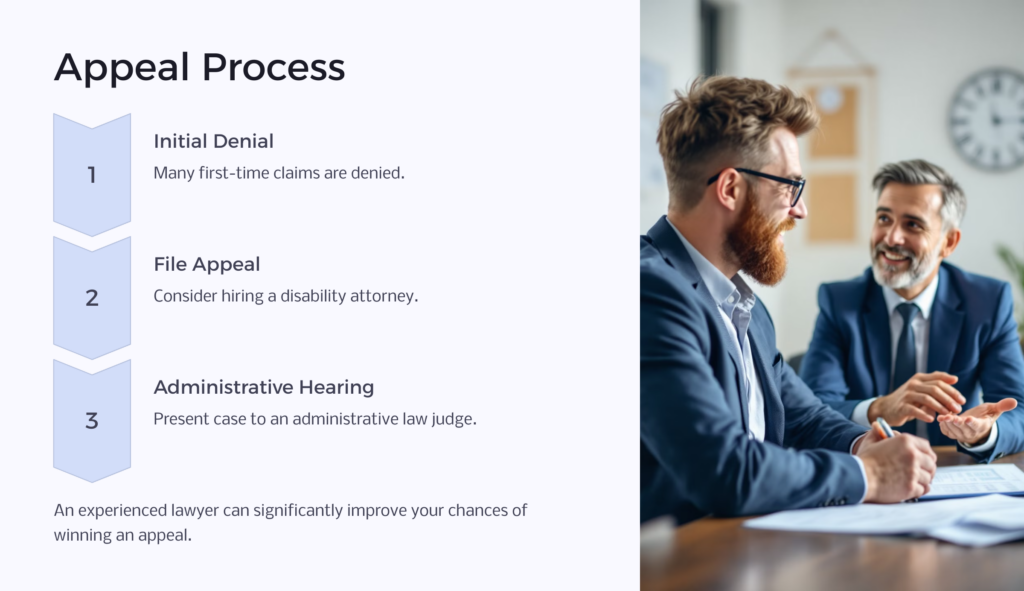Can you get disability for diabetes?
Having diabetes by itself usually will not enable you to qualify for Social Security Disability (SSDI). Many people have diabetes and can work normally. However, if you cannot control blood sugar levels throughout the day, symptoms such as dizziness, vision problems, numbness, or other conditions that impact your ability to work will be considered when you apply for SSD.

Normally, however, the difficulties caused by other related illnesses coupled with diabetes may make you eligible for disability benefits. For example, illnesses such as diabetic vision loss, peripheral neuropathy, heart disease, and kidney failure can be associated with diabetes and can be disabling.
Diabetes, especially when left untreated like many other invisible disabilities, can lead to various secondary illnesses and other medical conditions or complications. Some may be severe or life-threatening. We’ve listed some of the most common ones below.
11 Illnesses Related to Diabetes
-
Acidosis
-
Alzheimer’s Disease
-
Amputation of a Limb
-
Cardiovascular Diseases
-
Cerebral Edema and Seizures
-
Cognitive Impairments
-
Depression
-
Diabetic Nephropathy
-
Diabetic Retinopathy
-
Peripheral Neuropathy
-
Skin Infections that are slow to heal

The Social Security Administration (SSA) has developed listings for various diseases that could qualify for disability benefits. They refer to this list as their Blue Book. It allows Disability Examiners (DE) to quickly reference a specific disease and compare the listing with the actual symptoms of the claimant.
The Blue Book does not list diabetes as a qualifying disease because by itself, it does not meet the minimum standards needed by the SSA to be listed. It must be diagnosed in conjunction with specific impairments to bring a person’s limitations up to the level required for benefits. The impairments caused by the related diseases would be evaluated on their own under that disease’s listing. These illnesses are relevant if they prevent you from working and performing substantial gainful activity (SGA), which in 2020 was the ability to earn $1,260 gross wages or net self-employment profit monthly ($2,110 if you are blind).
Illnesses Related to Diabetes
Various medical conditions and illnesses are often related to uncontrolled diabetes. The longer you have diabetes and the more poorly managed blood glucose, the higher your risk for any of the following complications. That’s why it’s vital to seek long-term disability benefits by checking these related illnesses:
1. Acidosis
Acidosis is characterized by an unhealthy level of acid in body fluids, typically caused by the kidneys and lungs not working effectively. As a result, they lose the ability to keep the body’s pH level in an appropriate balance. Normally, the body’s pH level should be around 7.4; for patients with acidosis, the pH level is typically around 7.3 or lower, indicating a more acidic level.
Symptoms of acidosis typically include weakness and abdominal pain. Patients with diabetes often also show some level of acidosis because of the body’s low level of insulin, which allows ketones to build up in the body, making its environment more acidic. When acidosis is combined with diabetes for an SSDI benefits claim, acidosis levels must be regularly documented every two months.
2. Alzheimer’s Disease
Alzheimer’s disease is a progressive and fatal mental disorder that, over time, erodes a patient’s ability to make judgments, learn, reason, remember, carry out daily activities, and communicate. Some patients with Alzheimer’s may also demonstrate personality changes, including becoming paranoid or suspicious, becoming easily agitated, and suffering delusions.
Diabetes patients, especially those with type 2 diabetes, appear more at risk for developing Alzheimer’s disease and other types of dementia. The poorer the patient can control blood glucose, the higher the risk seems to be. Research is beginning to show that high blood glucose levels can be linked to a higher incidence of Alzheimer’s disease, which is the most commonly diagnosed type of dementia and the seventh leading cause of death in America.
3. Amputation of a Limb
Loss of a limb, especially a foot, is not uncommon for patients with diabetes. Nerve damage or lack of blood flow to the feet can lead to various medical complications, and wounds to the foot, even minor ones like scrapes or blisters, may not heal as they should. If you’ve had a limb amputated due to complications from diabetes, this may make you eligible for disability benefits. This is especially true if you have other documented limitations, which your doctor can help you determine.
4. Cardiovascular Diseases
Having diabetes dramatically increases your chances of a wide variety of related cardiovascular issues. Cardiovascular conditions typically associated with diabetes may include an irregular heartbeat, peripheral vascular diseases, or even congestive heart failure, which carries symptoms ranging from pain and fatigue to numbness. If you have diabetes, you are also at increased risk of a heart attack or stroke.
5. Cerebral Edema and Seizures
Cerebral edema is the presence of too much fluid and/or swelling around the brain. This condition can cause headaches, dizziness, nausea, unconsciousness, and permanent brain injury. Consequences can be deadly if not managed well. Cerebral edema results in excessive pressure building up around the brain, which can lead to reduced blood flow to the brain, along with low oxygen levels going to the brain.
Sometimes, seizures also occur directly from diabetes, often related to an extremely low blood sugar level. These seizures can happen when a diabetic patient injects too much insulin or doesn’t eat correctly after insulin injections, or even when a diabetic patient exercises too strenuously without eating appropriately. A diabetic seizure is always a serious emergency that requires immediate medical attention. This regular occurrence may lead the SSA to determine that a diabetes patient cannot work.
6. Cognitive Impairments
Some research supports the idea that people who develop diabetes earlier in life, suffer more severe symptoms, and live with diabetes longer may also suffer some cognitive impairments, like memory loss and language difficulties. Severe diabetes is often linked to poorly managed blood glucose and high blood sugar, which potentially can damage blood cells that nourish the brain. Also, people who suffer from diabetic retinopathy are almost twice as likely as other diabetes patients to suffer from cognitive impairment.
Both Type 1 diabetes and Type 2 diabetes patients have shown reduced performance in cognitive functioning. Cognitive deficits can appear very early in the disease’s life cycle, only to be further exacerbated over time. Those who live with diabetes are about one and a half times more likely to demonstrate declines in cognitive function than those who don’t.
Many secondary conditions associated with diabetes are painful, and pain causes tremendous problems when it comes to thinking clearly or the ability to problem-solve. Dealing with chronic pain also raises a patient’s chances of suffering from either anxiety or depression. As part of your Social Security disability benefits application process, your thinking ability and capacity for focus may need to be assessed as the SSA evaluates your disability claim.
7. Depression
Many people living with uncontrolled diabetes also develop depression. Living with this serious disease can be extremely difficult, especially if it’s accompanied by other painful related medical conditions that can affect mental health. It’s very common for diabetes patients – both Type 1 diabetes and Type 2 – to also be treated for depression, and the relationship seems complicated. The rigors of diabetes can lead someone to feel depressed, which can interfere with the ability to make good life choices that control blood glucose and keep diabetes under control, which, in turn, can lead to more painful symptoms and additional depression.
If not managed carefully, diabetes and depression can work together in a vicious cycle of poor health. If you have diabetes, symptoms of depression to watch out for include loss of interest in activities you previously enjoyed, feelings of hopelessness, and even physical symptoms like headaches. For your Social Security disability benefits application, depression is addressed in listing 12.04, Depressive, Bipolar and Related. If your disabling condition meets the listing criteria, it may render you eligible for SSDI benefits.
8. Diabetic Nephropathy
Your kidneys are filled with small blood vessels in clusters that filter waste from your blood. Diabetic nephropathy is a kidney disease that occurs when the kidneys aren’t filtering out toxins. This leads to high levels of creatine and/or protein. When this is the case, patients often must have dialysis regularly and may be eligible for SSDI benefits. Without dialysis, the body cannot rid itself of waste, resulting in a dangerous level of toxins – a condition called uremia.
Severe kidney damage may lead to kidney failure or irreversible end-stage kidney disease, often requiring a kidney transplant. Diabetic nephropathy is the No. 1 cause of kidney failure; nearly a third of diabetes patients will suffer from it. Symptoms may include swelling in the hands and feet, poor appetite, weakness, nausea, trouble sleeping, and itchy or extremely dry skin.
9. Diabetic Retinopathy
The effect of uncontrolled diabetes on your eyes directly results from higher glucose levels in the blood. The typical first sign of diabetes affecting a patient’s eyes is a change in the fluid level in the portion of your eye that controls focus. When this happens, some patients report no symptoms, while others report blurred vision. However, the vision complication may subside if blood glucose returns to a healthy level.
Diabetic retinopathy is usually more serious – it refers to nerve damage to the eyes’ blood vessels, once again caused by high levels of glucose in the blood. When these blood vessels suffer damage, they can leak fluid, which increases pressure and swelling in the eye. This damage then causes peripheral vision loss and may lead to blindness. People classified as legally blind because of this diabetes-related condition may qualify for SSDI benefits.
In addition to diabetic retinopathy, uncontrolled diabetes can put patients at risk of other severe eye issues such as macular edema, glaucoma, and cataracts. Roughly half of diabetes patients who develop diabetic retinopathy also will develop macular edema. Any severe vision problem can increase your chances of eligibility for Social Security disability benefits. For example, being unable to drive a car or see well enough to appropriately complete work tasks is generally considered a severe enough disability to merit disability benefits.
10. Peripheral Neuropathy
Excess glucose in the blood can damage the walls of the delicate blood vessels that carry blood to your nerves, especially those in the legs. As a result, patients suffering from peripheral diabetic neuropathy often report tingling, burning, numbness, or pain that travels from the tips of the fingers or toes and travels upward. This type of nerve damage can cause severe pain that’s near-constant for the patient and is extremely difficult to treat. The most effective treatment is effective management of blood glucose, followed by medication that can help manage nerve pain and make a patient feel more comfortable.
This is nerve damage that, to be eligible for SSDI benefits, must affect at least two of your extremities. The peripheral neuropathy must impede your ability to stand or walk. Left untreated, peripheral neuropathy can eventually lead to losing all feeling in the hands or feet.
11. Skin Infections that are slow to heal
People suffering from diabetes often have trouble healing from infections, especially superficial skin wounds. As many as one in three diabetes patients will develop some type of skin issue. Patients with diabetes are also more susceptible to skin infections, including fungal and bacterial infections.
The list of skin issues that seem to prey on diabetes patients is long and varied, ranging from simple pruritus (or itching of the skin) to dangerous skin infections like those caused by Staphylococcus aureus. Many of the most common skin ailments are either caused or exacerbated by a lack of appropriate blood flow, often seen in diabetes patients with poorly managed blood glucose. Also, patients with uncontrolled diabetes can develop styes (infections of the eyelid glands) and may more easily develop fungal infections in their fingernails and toenails.
To be eligible for SSDI benefits, you must have medical documentation of skin infections that fail to appropriately heal within three months, making walking or using your hands difficult or impossible.
It is important to note that meeting the listings is only one way to qualify for benefits based on diabetes/diabetes-related illnesses. If you have a severe condition but do not meet the listings, your work history, training, education, and age will be considered in determining whether you can work in any occupation possible with your physical limitations. (See Residual Functional Capacity below.)
Follow Your Doctor’s Orders
Left untreated, some of the ailments listed above can lead to death. If you do not follow your doctor’s treatment plan, benefits may be denied. For example, if your doctor told you to come in for regular follow-up appointments, lose weight, test your insulin level regularly, take medication or insulin shots, get physical therapy, etc., and you are not following through, the disability examiner may conclude that your symptoms are not severe enough to keep you from working.
Residual Functional Capacity

Most applicants are not granted benefits based on the listings because the requirements of the impairments are high, so there is another test to see if you would qualify. If you do not meet the impairment listings in the Blue Book, your disability claim will be evaluated to determine if a medical-vocational allowance can be granted.
A medical-vocational allowance review is used when your impairments do not match the exact description in the Blue Book. A Residual Functional Capacity (RFC) assessment is often obtained to assist in the review. This evaluation rates how your medical or psychiatric condition limits you. Your doctor may be asked to complete an RFC. However, some doctors as a matter of policy will not make an RFC statement, or you may be asked to see a physician selected by Social Security for the evaluation. The RFC determines your ability to stand, walk, sit, bend, push, pull, lift, and carry objects or, in the case of mental illness or impairment, your ability to reason, follow directions, be around people, and cope with stressful situations.
Diabetes and related conditions could affect your RFC if:
-
Your vision is 20/70 or more and not correctable, you will not be able to drive.
-
Your poor circulation results in numbness in your extremities, your manual dexterity and ability to stand/walk could be
impacted. -
Also, loss of cognitive ability may happen if you cannot maintain consistent glucose levels throughout the day.
If your vision is poor or you have difficulty in controlling your blood sugar level, this may be a reason to stop driving. Also, if driving is part of your job duties, this would prevent you from working in occupations requiring driving or working around machinery with moving parts as you could place your own life in danger and the lives of others.
Also, driving is such a part of American life that if you give it up and have to find another means to travel to work or the grocery store, it would go a long way toward illustrating to the SSA how serious your problems are. If you refuse to stop driving even though you are having these difficulties, it could damage your credibility in a Social Security hearing. This is because the judge may think your disease impairments aren’t as serious as you claim since you continue to drive.
Your psychological state could also be affected by your disease, so your thinking ability and your capacity for focusing may be assessed. In addition to those appraisals, your medical records will be reviewed, and statements may be taken from friends, relatives, and co-workers.
Concerning physical capacity, the examiner determines which category your limitations best fit in: medium work, light work, or sedentary. Your residual functional capacity-what you can do- will give the examiner a basis to decide if you would be able to return to your previous job. If you cannot, your limitations are considered along with your age, work history, schooling, skills, and job training to determine whether you can work in another occupation.
To determine your vocational ability to work, the examiner considers your limitations stemming from all your medical and mental conditions, including diabetes and related illnesses. The disability examiner may find that because of your impairments, you are not capable of returning to your past work or any other type of job, even with on-the-job training. If so, it will be determined that you are disabled. Expectations of your ability to start new occupations are higher if you are younger than fifty than if you are fifty to fifty-five years old. It is likely that other jobs you could perform will be identified. If you are older than 55, the number of jobs may be limited because you are approaching retirement age with less ability to compete for and be successful in a new occupation. Accordingly, your chances of approval are a bit stronger than those of younger applicants.
Appeal

The requirements to obtain Social Security Disability for diabetes or related conditions are very high. This is why first-time claimants are often denied benefits. However, it is possible to appeal the initial finding. If you obtain the assistance of an attorney who specializes in Social Security Disability claims, your chances of winning an appeal increase. If your first appeal is denied, you can seek a hearing in front of an administrative law judge.
Using an experienced Social Security disability lawyer allows you to take advantage of their knowledge and skills to develop a compelling disability case to obtain benefits. For example, your disability lawyer might bring in experts, neighbors, or co-workers to explain in more detail how your limitations severely disrupt your life. Your attorney may also be able to cross-examine Social Security’s experts to show the weaknesses in their conclusion. Although you can appeal your denial by yourself, it would be to your advantage to have a disability benefits attorney represent you to present the best case to obtain a reversal of your benefit denial.
 Benefits.com Advisors
Benefits.com Advisors
With expertise spanning local, state, and federal benefit programs, our team is dedicated to guiding individuals towards the perfect program tailored to their unique circumstances.
Rise to the top with Peak Benefits!
Join our Peak Benefits Newsletter for the latest news, resources, and offers on all things government benefits.




















